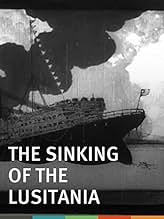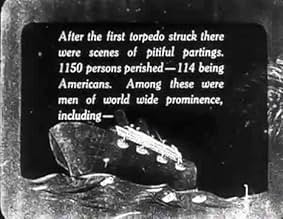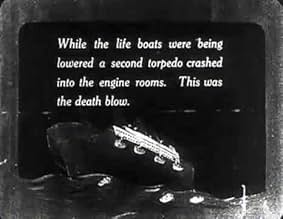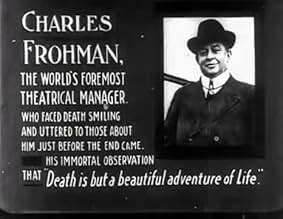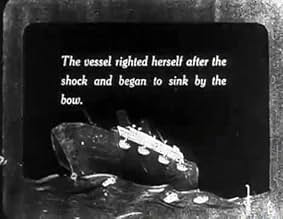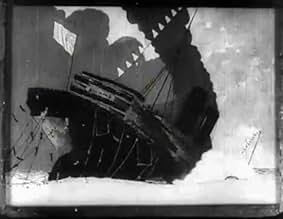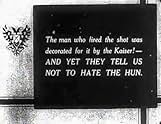IMDb RATING
6.8/10
1.3K
YOUR RATING
An animated dramatization of the notorious World War I German torpedoing of the ocean liner, Lusitania.An animated dramatization of the notorious World War I German torpedoing of the ocean liner, Lusitania.An animated dramatization of the notorious World War I German torpedoing of the ocean liner, Lusitania.
- Director
- Writer
- Star
- Awards
- 1 win total
- Director
- Writer
- All cast & crew
- Production, box office & more at IMDbPro
Featured reviews
This is a tough animated film to rate, as in some ways this is a wonderful film and in others it's lousy. When it comes to mobilizing the American public to demand war and volunteer to fight abroad, it was top-notch propaganda. It did so much to justify our entry into the war to destroy the evil Hun! But, history has shown us a lot that was not discussed in the film. First, the Lusitania was not an innocent passenger liner. Recent dives have found detonators and other contraband were being carried on this passenger liner. Second, the Germans were at fault for this pointless war--as were the Russians, Austria-Hungarians, French, British, etc.! And third, although widely circulated during the war as a deliberate hoax, the Kaiser did NOT decorate the captain of the sub for sinking the Lusitania!! If you ignore all the controversy above and just focus on the quality of the animation, for 1918, this is an amazing film. Well animated with excellent backgrounds and a jerking and super-effective finale featuring a drowning mother and her child--this is an amazing film. While most today would probably find the animation primitive and dull, for its time it was terrific. Too bad the central message is so fatally flawed and inaccurate.
McCay's animation is hypnotic and the realism is shocking. It's all on the same horizontal plane of action, but that makes it so strong and potent to look at, since the point of view doesn't change too much, except to show people falling off the boat. The intertitles don't help so much; they break up the flow of the images and even down to seeing the names and faces and bios on certain 'famous' people of the period (major figures I'm sure but still a distraction), and I wanted to get more Windsor McKay drawings. Showing his process was fascinating too, as the short begins with McKay getting his drawing-marching orders, and you see how he starts with the water, and then lays in everything else. The most shocking part comes with those little figures falling off the ship in droves, but each one has enough detail that they can be distinguished as human beings.
From Winsor McCay, the revolutionary animation pioneer and director of the charming classic "Gertie the Dinosaur" comes a much darker animated tale. This film recounts the tragic striking and sinking of the Lusitania which took away over 1000 lives. This film is highly respectful in execution, and it certainly isn't what you would expect from McCay, who normally crafted extremely funny and enjoyable animations rather than heartbreaking dramas. But, although its execution is much different than any other silent drama on the subject could be, it is highly effective and powerful, not to mention well made! The animation is wonderfully done, and doesn't look too "cartoony" for the depressing subject matter. McCay creates haunting and slightly propagandic images with this invention, images that wouldn't have been successfully captured on a 1918 movie set.
Animation historians must view this film immediately, but I suppose if you can find one McCay cartoon you can find them all - they're compiled on the 'Animation Legend' video and DVD. 'Lusitania' is the film where McCay tries to escape the caricatural confines of the animated picture to produce a serious and moving film, and damn, he succeeds. The meticulous care which he put into the thousands of drawings necessary for this short cartoon meant that by the time it was finished, it was barely topical and WWI was over, leaving its calls for vengeance somewhat stranded. However, as a study of technique it is perhaps unsurpassed. McCay's animation has a dimensionality which is worlds apart from the character animation of Koko the Klown or Felix the Cat, perhaps a deliberate differentiation from such gentle entertainments. The grim monochrome images of the Lusitania's stern raised in the air while hundreds of people leap to their deaths while remind most audiences of shots from James Cameron's 'Titanic'. While the barely-concealed rage and maudlin tributes to the famous noblemen who died in the sinking (as opposed the penniless plebs who we can afford to forget) now appear unpalatably heavy-handed, the elegant curls of smoke from the stricken vessel are simply powerful cinematic touches which seal McCay's reputation as one of the great film artists of the silent era. If only he, and not Disney, had become the template for the future of American animation...
The Sinking of the Lusitania (1918)
*** (out of 4)
This WWI propaganda piece is from Winsor McCay, the famed animator who decided to use his skills and so something quite different. This film documents the German attack on the Lusitania ship, which was carrying 2000 people when it was hit by a couple torpedoes and sank fifteen-minutes later. The film clocks in at twelve-minutes and the animation is used to show what happened and then we're given actual footage talking about how evil Germany is and we also have a brief tribute to some of the men who were lost. This is a fairly interesting film on many levels but the biggest is because of all the fire and passion that McCay brings to the material. There's no doubt that this was a very personal film to him and he clearly makes his feelings known by attacking Germany on pretty much every level. There's no question that the gloves are off as the title cards are quite damning to the actions that were done that day. The animation of the boat sinking is quite simple on one hand but I'd argue there are still some very striking moments here. I think the greatest are the shots of the ship and the smoke coming from it. The long, complete shots of the ship are quite striking in their animated form and just watch the way that the smoke comes off of it. The previously mentioned tribute shows some of the famous people that died on the ship, which was somewhat questionable and especially since none of the other victims are even mentioned and no tribute is given to them. With that said, this is still very much worth seeing just for the passion that it displays.
*** (out of 4)
This WWI propaganda piece is from Winsor McCay, the famed animator who decided to use his skills and so something quite different. This film documents the German attack on the Lusitania ship, which was carrying 2000 people when it was hit by a couple torpedoes and sank fifteen-minutes later. The film clocks in at twelve-minutes and the animation is used to show what happened and then we're given actual footage talking about how evil Germany is and we also have a brief tribute to some of the men who were lost. This is a fairly interesting film on many levels but the biggest is because of all the fire and passion that McCay brings to the material. There's no doubt that this was a very personal film to him and he clearly makes his feelings known by attacking Germany on pretty much every level. There's no question that the gloves are off as the title cards are quite damning to the actions that were done that day. The animation of the boat sinking is quite simple on one hand but I'd argue there are still some very striking moments here. I think the greatest are the shots of the ship and the smoke coming from it. The long, complete shots of the ship are quite striking in their animated form and just watch the way that the smoke comes off of it. The previously mentioned tribute shows some of the famous people that died on the ship, which was somewhat questionable and especially since none of the other victims are even mentioned and no tribute is given to them. With that said, this is still very much worth seeing just for the passion that it displays.
Did you know
- TriviaAs First Lord of the Admiralty Winston Churchill allowed civilian ships to transport war munitions for the Western Front. He prevented German U-Boats from searching the ships by illegally arming merchant ships, introducing Q-ships with concealed deck guns, and by ordering merchant captains to evade and submarines that surfaced.
- GoofsThe German submarine fired only one torpedo, not two. The second explosion originated from within the ship near where the torpedo hit. The cause still remains uncertain. It has been widely speculated that the second explosion was caused by war munitions the ship was illegally transporting for the Western Front.
- ConnectionsEdited into Los comienzos de la animación (1995)
Details
- Release date
- Country of origin
- Languages
- Also known as
- The Sinking of the 'Lusitania', an amazing moving pen picture by Winsor McCay.
- Production company
- See more company credits at IMDbPro
- Runtime12 minutes
- Color
- Sound mix
- Aspect ratio
- 1.33 : 1
Contribute to this page
Suggest an edit or add missing content

Top Gap
By what name was The Sinking of the 'Lusitania' (1918) officially released in Canada in English?
Answer
